When things go wrong with Windows, as they sometimes will, nothing ensures a faster or easier return to normal than restoring a recent image backup.
To that end, I back up my production PCs at 9 a.m. every day. That means that I’ll never lose more than a day’s work if something should go badly enough wrong to force that day’s image backup to be restored.
In the sections that follow, I explain what all this means, how it works, and why you shouldn’t use built-in backup in either Windows 10 or 11. Finally, I’ll walk you through how to use my favorite free image backup tool while recommending a couple of other acceptable alternatives.
What is an image backup, anyway?
Simply put, an image backup is a snapshot of the complete contents of all partitions on a computer’s C: drive. In other words, it’s an exact copy (“image”) of the drive — operating system, data files, settings, and all — not just the files stored on it. Image backups are sometimes called system image backups, whole-system backups, full system backups, or other variations on that theme.
If you look at the disk layout for a typical C: drive, you’ll see that it usually includes four or more partitions, as shown in Figure 1.
 IDG
IDGFigure 1: The default Windows 10 and 11 disk layout comprises 4 partitions: (1) EFI, (2) MSR, (3) Windows OS, and (4) Windows Recovery Environment (WinRE). (Click image to enlarge it.)
(Please note: I use the excellent, no-cost MiniTool Partition Wizard Free instead of Windows’ built-in Disk Management tool because Partition Wizard shows the Microsoft Reserved, or MSR, partition along with other partitions on the C: drive; in Figure 1 it occupies 16MB in position 2.)
When you make an image backup, all the bits and bytes for each partition are captured. And when an image backup is restored, the previous contents of the drive are overwritten, as the image for each partition is written to the target drive afresh and anew.
How image backup works
Making an image backup involves making a snapshot of the contents of each partition on one drive and storing those contents within an image copy for each partition on another drive. TechTerms.com describes a disk image as “a software copy of a physical disk” that “saves the entire data from the disk, including the file structure and folders from the disk, in a single file.”
Thus, each partition is captured in its own image file. Given the right software, in fact (I’ll show a demonstration later on in this story), you can explore an image just as if it were a standalone file system.
To create an image, special software is used to build the single file (or collection of files) that represent the whole disk or its constituent partitions. Disk image files are often stored using special binary formats. Thus, for example, the .ISO image format (a CD- or DVD-oriented disk image format based on the ISO-9660 standard, which Microsoft uses to distribute images of the Windows installation environment) contains an exact duplicate of a disk image, including data saved in files on that disk, as well as file system information and related metadata.
Don’t use the built-in Windows backup utility
In Windows 7, Microsoft built a Backup and Restore utility into the OS. It’s still present in Windows 10 and 11 (shown in Figure 2 at the top of the Control Panel window), but it’s currently called “Backup and Restore (Windows 7),” which provides an important clue about its status.
 IDG
IDGFigure 2: While the Backup and Restore (Windows 7) utility is still around, there are much better options.
Microsoft has clearly backed away from the tool. The company’s current “Backup and Restore in Windows” support article mentions the Backup and Restore (Windows 7) utility only in the context of restoring from system image backups created “in previous versions of Windows.”
Having followed ongoing backup and restore discussions on Windows Ten Forums since October 2014, and on Windows Eleven Forum since June 2021, I can say that none of the participants speak in favor of using the tool any longer. In fact, most Windows gurus recommend using something else because of occasional (but credible) reports of problems when restoring images made using the Backup and Restore (Windows 7) tool. Fortunately, there are better options available.
Back up and restore Windows with third-party backup tools
There are at least three workable, respectable, and highly regarded free Windows backup tools that work with both Windows 10 and Windows 11:
All three tools make compact, speedy, and reliable image backups of Windows 10 and Windows 11 PCs. I have been a devoted user of Macrium Reflect Free for a decade now, and present its use on Windows 11 in the following screenshots as an illustration of how such programs work. (Your mileage may vary, depending on which tool you choose.)
Create (and schedule) image backups
Macrium provides a left-column menu entry under the “Create backups” tab that reads “Create an image of the partition(s) required to backup and restore Windows.” Though there are many other options and capabilities in the program, this is exactly what’s needed here, so I’ll step you through working with this facility.
Upon clicking the entry, a map of the Windows (C:) drive appears with two of the four partitions checked, as shown in Figure 3. I recommend checking all four partitions before proceeding.
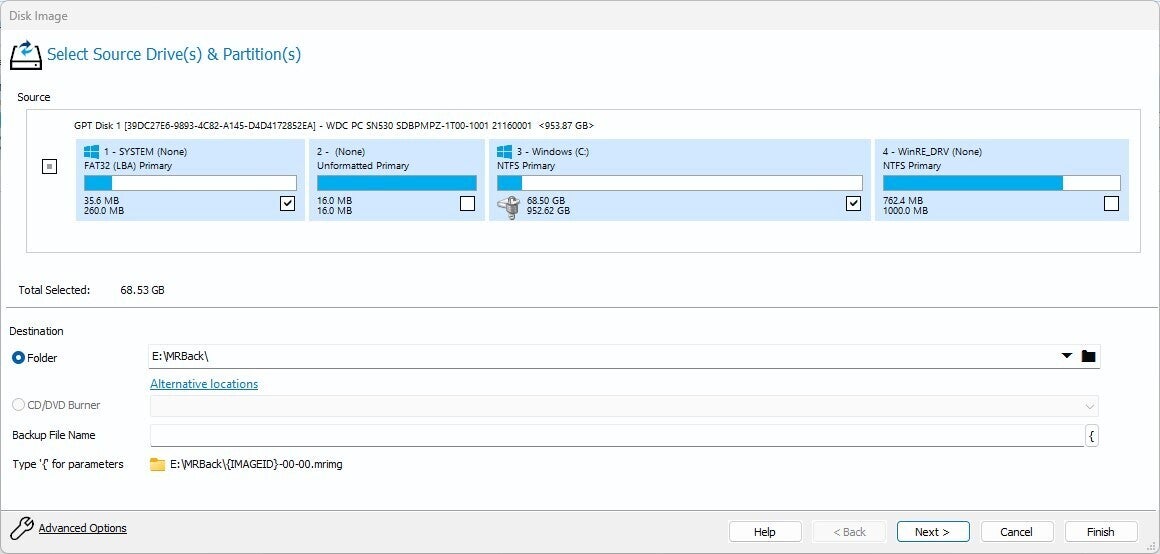 IDG
IDGFigure 3: By default, only the EFI (#1) and Windows (#3) partitions are checked. I recommend checking all four. (Click image to enlarge it.)
The Destination folder shows where backups will reside. On my Windows 11 test machine, that’s E:MRBack. The first time you use this program, you must target some drive different from C: and specify a “home directory” for your backups. The best target for backups, in fact, is an external drive (usually USB); if a system goes really south, you can use the external drive to restore things to a different PC more easily. Click Next > (at lower right) to move to the next screen.
This calls up the “Backup Plan” window, wherein you can specify some kind of backup plan (called a “Template” in the program), as shown in the choices visible in the pull-down menu in Figure 4.
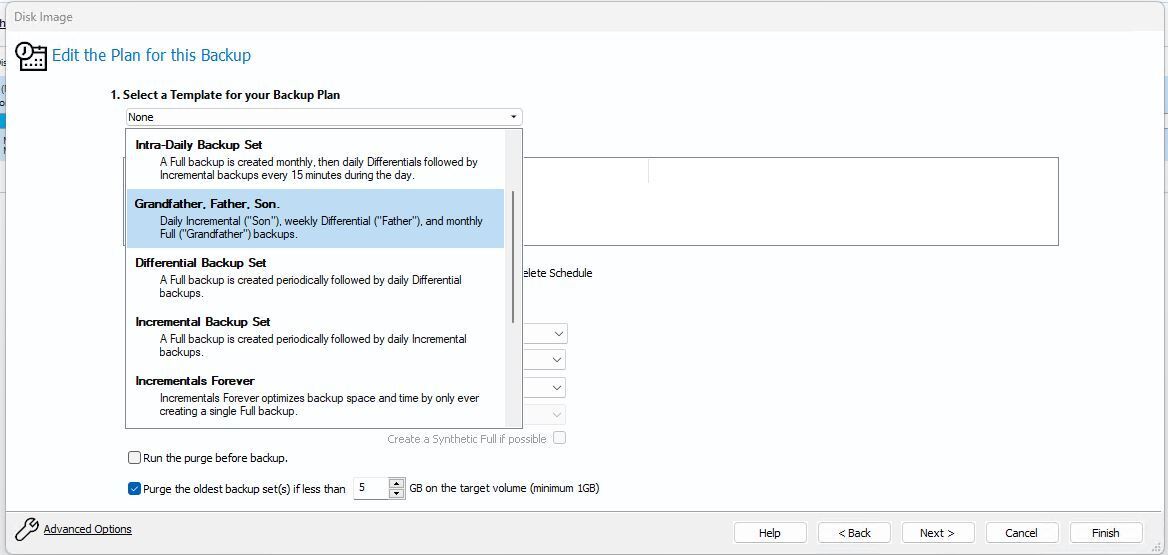 IDG
IDGFigure 4: Macrium Reflect offers a well-documented collection of six different backup plans. (Click image to enlarge it.)
The most inclusive backup plan is shown at the top of the list and features a full backup each month, plus daily differential backups (everything changed since the previous day) and incremental backups (anything new or changing) every 15 minutes all the time. This offers the best overall protection but requires at least 100-200GB of disk space (more is better) for best results.
Figure 5 shows plan settings should you pick the Intra-Daily Backup Set as your plan, recommended for those looking to obtain maximum data protection, with a big (and relatively empty) drive on which to back up. Macrium Reflect lets you edit the default backup schedule and number of backups saved for the plan. (Note: my backup drive on this PC offers a nominal 5TB capacity that File Explorer reports as 4.54 TB actual capacity.)
 IDG
IDGFigure 5: The Intra-Daily Backup Set properly describes incremental backups as “Stealth,” because they’re missing from the retention rules (too many to track and log, in fact). (Click image to enlarge it.)
When you click Next > at the bottom of the Backup Plan window, Reflect presents a disk image screen that shows you the options you’ve selected (see Figure 6). Notice that the “Total Selected” size for each image is 69.29 GB; because the program uses sophisticated and capable compression, each resulting full backup snapshot is actually 35GB in size. (Differential and incremental backups seldom amount to 10% of that number, though this will vary based on file activity and changes.)
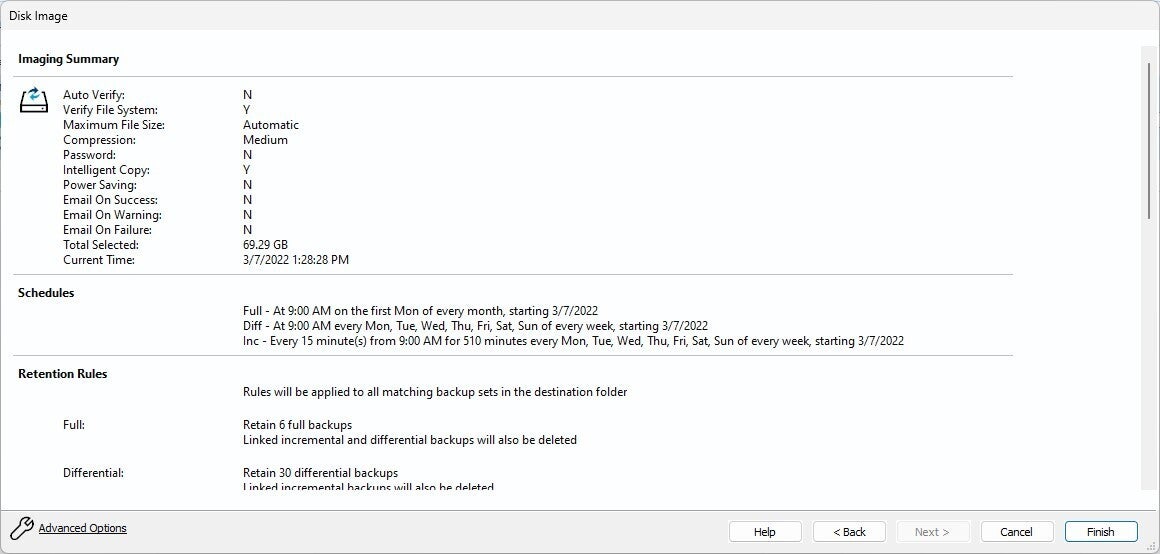 IDG
IDGFigure 6: The “Disk Image” pane stores the details that describe the backup’s schedule and types. (Click image to enlarge it.)
Click Finish to complete the backup description process. Then you’ll be presented with a pane that provides options to “Run this backup now” and “Save as an XML Backup Definition File” what you’ve just defined. (Both options are selected by default, as shown in Figure 7.) To fire off your first such backup, click OK.
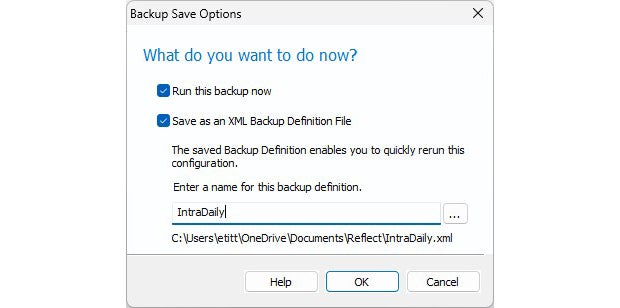 IDG
IDGFigure 7: I named this XML file “IntraDaily.xml” and left the boxes checked. You could do likewise.
Once the OK button is clicked, the first full backup runs. On my test system, that took about 6 minutes in all. Note further that the on-disk size of the backup is 31.85GB (more than 50% compression). Figure 8 shows the results from the first full backup run.
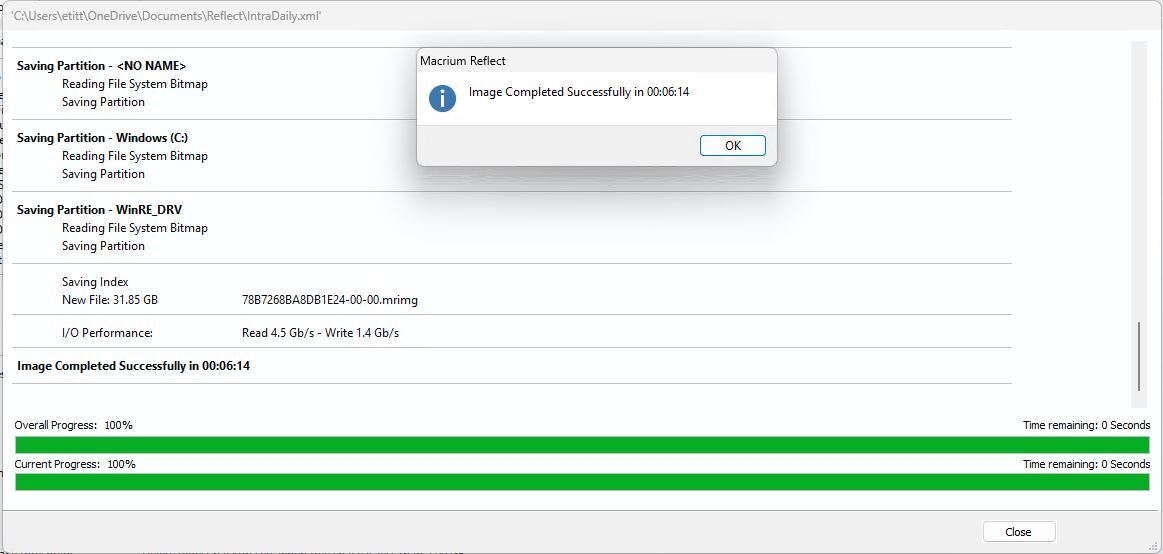 IDG
IDGFigure 8: First full backup results took 6:14 and consumed 31.85GB disk space. (Click image to enlarge it.)
One of my reasons for sticking with Reflect is its speed: to the best of my knowledge neither of the other two programs I mentioned earlier is quite as fast. Because it runs in the background on reasonably fast PCs, I hardly ever notice it’s working, which is just what you want in a backup program.
Restore an image backup
Should you ever need to restore an image backup, it’s an easy thing to do. Typical reasons range from the sublime (such as OS corruption, driver failures, boot manager problems, malware attacks) to the ridiculous (accidentally deleted key OS files to make a system unusable).
Though Macrium Reflect (and the other programs cited earlier) offer program menu-based restore functions that are easy to use, when a restore is needed, I often find myself turning to the program’s Rescue Media. It is bootable, and smart enough to let you point to the backup image you wish to restore quickly and easily. For me, that usually means the most recent backup before things started going south.
The built-in Restore menu works almost exactly like the restore function available from Reflect’s Rescue Media boot-up. A pop-up menu item that appears when you click Restore in the program menu reads “Browse for an image or backup file to restore,” as shown in Figure 9. That’s the one you want.
 IDG
IDGFigure 9: Click the top menu item shown to browse a list of available backups. (Click image to enlarge it.)
It is important to know the drive letter for your image backups and the name of the folder where they’re stored. On my test PC, I know that’s Drive E: in the MRBack (short for Macrium Reflect Backup) folder, where such backups take an .mrimg (Macrium Reflect image file) extension. There the latest backup is easily identified by its timestamp, as shown in Figure 10. THAT’s the one I would want to restore.
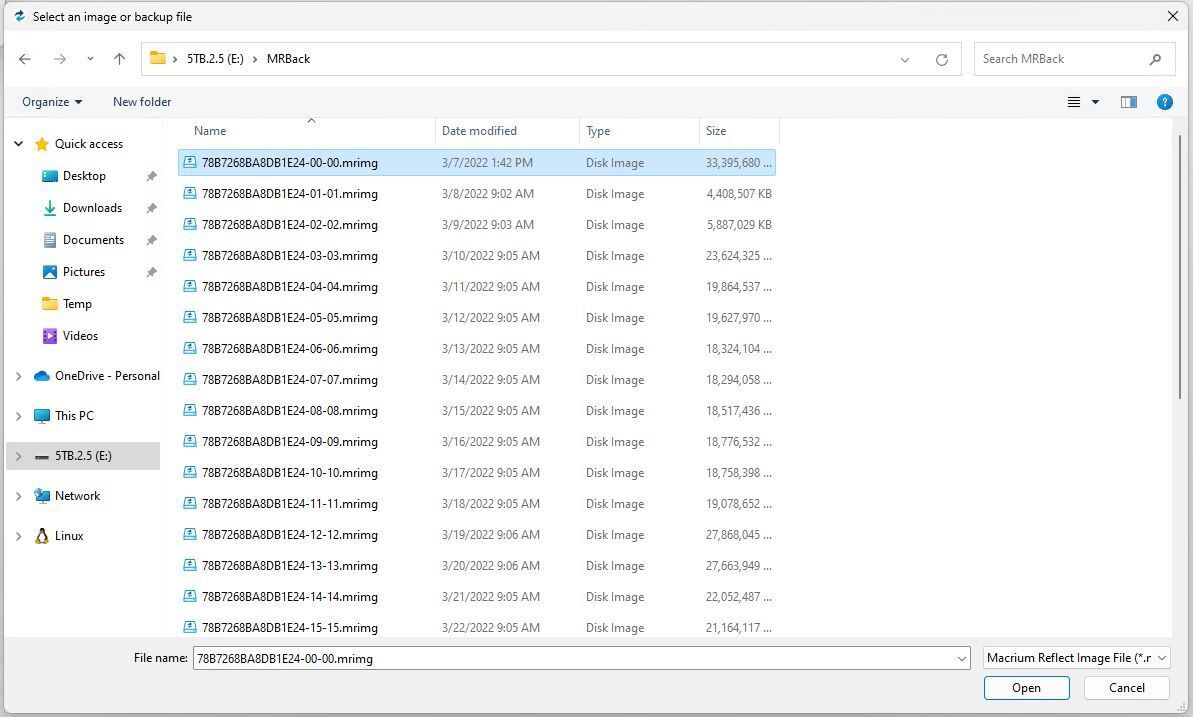 IDG
IDGFigure 10: Select the backup you want, then click the Open button at lower right to start the restore process. (Click image to enlarge it.)
Simply click the Open button to get that process underway: Macrium Reflect does the rest.
Macrium Reflect (and the other programs) also offer file- or folder-based restore capabilities. To use them, you’d click the “Explore image” item shown in the number 2 position in Figure 9. This opens a File Explorer-like interface that lets you designate which image you wish to explore, then select files and/or folders within that image to restore to the current running Windows image. It’s just like copying files and folders, which I assume readers can handle without step-by-step instructions, so I’ll skip those details here. For the incurably curious, see the MR knowledge base article “Restoring a file and folder backup” for more information.
Pick your backup, and use it to the max!
My own choice is Macrium Reflect. You can pick any of the options I’ve presented here as you see fit. For speed’s sake, you may want to consider targeting a fast drive (ideally an NVMe PCIe-x4 SSD) on which your backup images will reside.
But the important thing is to back up regularly and often. That’s your best guarantee to minimize data loss if and when the time ever comes to restore a backup. Better to not need it and still have a backup than to need one and have none.
Read this next: For more Windows repair techniques, see “How to repair Windows 10 and 11 in 4 steps.”

